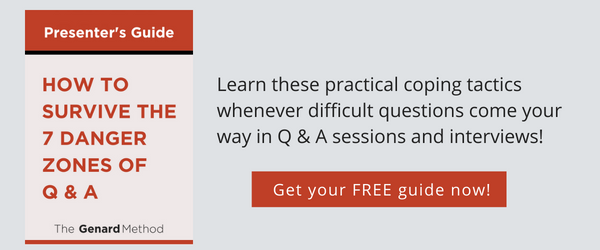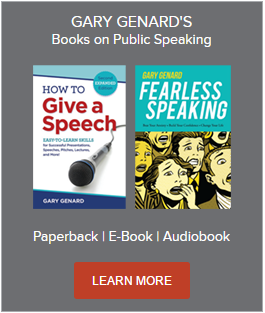
Anyone can give an okay presentation. But what about when the tough questions come? Here's how to think on your feet and speak effectively under pressure!
Is there anything more pressure-inducing than high-profile, high-stakes public speaking?
Let’s not event count the millions of people worldwide who have actual fear of public speaking. Even for the rest of us, speaking in public is always an exercise in handling pressure. Add the prospects of an important audience, a resistant one, or tougher Q & A than you expected, and you may think the nearest barometer has suddenly gone haywire.
Talk about situations where you need to stay focused! Give yourself a helping hand. Download my free cheat sheet, “10 Ways to Stay Fully Focused when Speaking.”
You might say that the way to handle such pressure is to create foolproof content. And you'd be partly right. But there’s another layer of preparation you need, one that has to do with your ability to think on your feet.
Below are two exercises designed to help you survive and even thrive in the public speaking pressure cooker. Both are useful in giving you practice in thinking on your feet. Use one or the other (or both), based on the type of pressure you’ll be facing. Remember, anyone can give an ordinary speech. It's your job to stand out from the crowd for career success!
Want to raise your profile for promotions? Get my new book, Speak for Leadership: An Executive Speech Coach's Secrets. Click here or below to learn more and to get it today!
Fast and Furious: How to Write a Speech Quickly
You’ll need a little lead-time for this one, though the actual exercise takes just fifteen minutes. Start by writing the most challenging topics or hot issues in your job, company, or industry. Think of pulling a topic out of a hat and you’ll literally understand the mechanics of this exercise.
Now put those slips aside. The idea here is to make you forget the topics you wrote down. When you come back to your stash, you’ll be facing each of them on the spur of the moment (almost). A variation of this part of the exercise is to have a colleague write the topics so you literally don’t know what you’re going to be asked.
When you’re ready, choose a topic from the “hat.” Now give yourself just fifteen minutes to compose a 3-5 minute talk that address this problem, challenge, or opportunity. Jot down key words and phrases only—don’t write out an entire speech.
And while you're writing, think carefully about what to say . . . and what not to say! Learn more in my Free White Paper, "25 Words to Avoid in Speeches and Presentations."
Here’s the rest of the instructions:
- You'll be making three assertions, and backing up each one with one piece of evidence. Evidence means personal anecdotes, expert testimony, statistics, customer testimonials, case study, etc. (You can make up evidence on the spot if you need to for this exercise, since you’re not giving yourself time to conduct any real research.)
- Find an interesting way to open your speech without simply blurting out your topic. Similarly, try to close strongly. Try to make both your opening and closing memorable.
- Videotape yourself and debrief yourself on the results.
Benefits: This exercise tests four competencies: 1) your ability to organize a coherent talk quickly; 2) your skill in marshaling evidence to strengthen a case; 3) your proficiency in constructing a logical argument; and 4) your dexterity in fashioning an interesting response that piques listeners’ interest.
Can you appear spontaneous and in-the-moment even when reading? You have to! Learn how in my Free resource, "How to Read a Speech and Still Be an Effective Speaker."
Turning Up the Heat: One-Minute Impromptus
Now you can really challenge yourself in terms of thinking fast while speaking eloquently. You'll do it by practicing an exercise I invented called “One-Minute Impromptus.”
The task in this exercise is simple but devilishly challenging. You'll have one minute to take notes on a topic a colleague gives you (or that you yourself have written down previously and "forgotten about," per above). Then, you'll immediately speak for one minute on that topic. You can use your notes to glance at if you need to. And I mean one minute, as in use a stopwatch.
Need help with nerves in situations like this? Who wouldn't? Download my 5-minute miracle exercise (and Free cheat sheet): "How to Calm Your Nerves Before Speaking."
Naturally, you’ll be best served by a topic that’s related to your work or the type of speaking you do. In particular, if you pitch business or routinely face tough audiences, One-Minute Impromptus is a natural skills- and confidence builder.
It may not seem that way at first. You may easily discover, for instance, that you find yourself thinking as the timer beeps: “But I didn’t get to my topic yet!"
In Round 2, you’ll do better. So, keep at it. Go through the exercise three, four, even five or six times in succession, using a different topic and videotaping yourself each time. Debrief your performances, either by yourself or with a colleague or even as a team. You may be amazed at how quickly your ability to speak logically and concisely on a topic improves.
Benefits: One-Minute Impromptus tests your ability to speak with clarity and conciseness and to get to the heart of the matter. Speak with this level of compactness and you’ll speak with impact. If you really want to practice thinking fast under pressure, this is the exercise for you.
This blog was previously published in 2016. It is updated here.
You should follow me on Twitter here.
What about the actual types of questions you'll be asked? Download my Free Presenter's Guide, "How to Survive the 7 Danger Zones of Q & A." Arm yourself to win!
Gary Genard is an actor, author, and expert in public speaking training and overcoming speaking fear. His company, Boston-based The Genard Method offers live 1:1 Zoom executive coaching and corporate group training worldwide. In 2022 for the ninth consecutive year, Gary has been ranked by Global Gurus as One of the World’s Top 30 Communication Professionals. He is the author of the Amazon Best-Seller How to Give a Speech. His second book, Fearless Speaking, was named in 2019 as "One of the 100 Best Confidence Books of All Time." His handbook for presenting in videoconferences, Speaking Virtually offers strategies and tools for developing virtual presence in online meetings. Contact Gary here.




